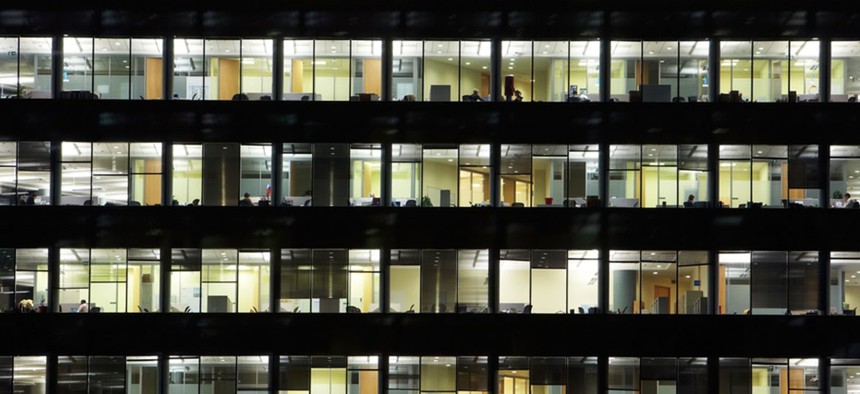
YanLev/Shutterstock.com
Why Americans Work So Much Despite Economist John Maynard Keynes' Prediction
The economist predicted a society so prosperous that people would hardly have to work. But that isn’t exactly how things have played out.
How will we all keep busy when we only have to work 15 hours a week? That was the question that worried the economist John Maynard Keynes when he wrote his short essay “Economic Possibilities for Our Grandchildren” in 1930. Over the next century, he predicted, the economy would become so productive that people would barely need to work at all.
For a while, it looked like Keynes was right: In 1930 the average workweek was 47 hours. By 1970 it had fallen to slightly less than 39.
But then something changed. Instead of continuing to decline, the duration of the workweek stayed put; it’s hovered just below 40 hours for nearly five decades.
So what happened? Why are people working just as much today as in 1970?
There would be no mystery in this if Keynes had been wrong about the economy’s increasing productivity, which he thought would lead to a standard of living “between four and eight times as high as it is today.” But Keynes got that right: Technology has made the economy massively more productive. According to Benjamin M. Friedman, an economist at Harvard, “the U.S. economy is right on track to reach Keynes’s eight-fold multiple” by 2029—100 years after the last data Keynes would have had. (Keynes did not specify what he meant by a “standard of life,” so Friedman uses per-capita output as a proxy.)
In a new paper, Friedman tries to figure out why that increased productivity has not translated into increased leisure time. Perhaps people just never feel materially satisfied, always wanting more money for the next new thing. “This argument is, at best, far from sufficient,” he writes. If that were the case, why did the duration of the workweek decline in the first place?
Another theory Friedman considers is that “in an era of ever fewer settings that provide effective opportunities for personal connections and relationships,” people may place more value on the socializing that happens at work. But the evidence for this “remains uneven at best,” and, once again, “its bearing on the abrupt change in trend in the U.S. workweek in the 1970s is far from established.”
A third possibility proves more convincing: American inequality means that the gains of increasing productivity are not widely shared. In other words, most Americans are too poor to work less. Unlike the other two explanations Friedman considers, this one fits chronologically: Inequality declined in America during the post-war period (along with the duration of the workweek), but since the early 1970s it’s risen dramatically.
Keynes’s prediction rests on the idea that “standard of life” would continue rising for everyone. But Friedman says that’s not what has happened: Although Keynes’s eight-fold figure holds up for the economy in aggregate, it’s not at all the case for the median American worker. For them, output by 2029 is likely to be around 3.5 times what it was when Keynes was writing—a bit below his four- to-eight-fold predicted range.
This can be seen in the median worker’s income over this time period, complete with a shift in 1973 that fits in precisely with when the workweek stopped shrinking. According to Friedman, “Between 1947 and 1973 the average hourly wage for nonsupervisory workers in private industries other than agriculture (restated in 2013 dollars) nearly doubled, from $12.27 to $21.23—an average growth rate of 2.1 percent per annum. But by 2013 the average hourly wage was only $20.13—a 5 percent fall from the 1973 level.” For most people, then, the magic of increasing productivity stopped working around 1973, and they had to keep working just as much in order to maintain their standard of living.
What Keynes foretold was a very optimistic version of what economists call technological unemployment—the idea that less labor will be necessary because machines can do so much. In Keynes’s vision, the resulting unemployment would be distributed more or less evenly across society in the form of increased leisure.
Friedman says that reality comports more with a darker version of technological unemployment: It’s not unemployment per se, but a soft labor market in which millions of people are “desperately seeking whatever low-wage work [they] can get.” This is corroborated by a recent poll by Marketplace that found that for half of hourly workers, their top concern isn’t that they work too much but that they work too little—not, presumably, because they like their jobs so much, but because they need the money.
This explanation leaves an important question: If the very rich—the workers who have reaped above-average gains from the increased productivity since Keynes’s time—can afford to work less, why don’t they? I asked Friedman about this and he theorized that for many top earners, work is a labor of love. They are doing work they care about and are interested in, and doing more of it isn’t such a burden—it may even be a pleasure. They derive meaning from their jobs, and it is an important part of how they think of themselves. And, of course, they are compensated for it at a level that makes it worth their while.
The prosperity Keynes predicted is here. After all, the economy as a whole has grown even more brilliantly than he expected. But for most Americans, that prosperity is nowhere to be seen—and, as a result, neither are those shorter workweeks.
(Image via YanLev/Shutterstock.com)






